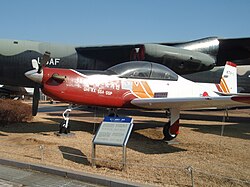KAI KT-1
| KAI KT-1 Ungbi | |
|---|---|

|
|
| Type: | Beginner training aircraft. Light attack aircraft |
| Design country: | |
| Manufacturer: | |
| First flight: |
November 1991 |
| Commissioning: |
2000 |
| Production time: |
since 1999 |
| Number of pieces: |
175+ |
The KAI KT-1 Ungbi (Hangul: KT-1 웅비) is a single-engine turboprop aircraft for beginners' training. It was jointly developed by Korean Aerospace Industries and the Defense and Development Agency (ADD). The KT-1 is the first aircraft developed entirely in Korea .
history
Development began under the KTX program for the South Korean Air Force in 1988. Nine prototypes were built from June 1991 for static and dynamic tests.
The first flight of the KT-1 took place in November 1991. In 1995 the project was officially named Ungbi . The final test flights took place in the course of 1998. In 1999, the contract for the delivery of 85 aircraft to the Air Force of South Korea was signed. The first KT-1 Ungbi was handed over in 2000 and delivery of the 85th machine was completed in 2002.
KT-1 can be equipped with either an analog or a so-called glass cockpit . Both configurations are used by the South Korean Air Force. The design of the KT-1 is very similar to that of the Pilatus PC-9.
Operational history
KAI exported seven units to Indonesia in 2003 and five more in 2005. In a press release dated March 8, 2006, KAI stated that it would export more than 150 improved copies of the KT-1 to various countries in Central America and Southeast Asia. The improved export version of the KT-1 is known as the KT-1C .
In June 2007, South Korea and Turkey signed a contract for the delivery of 40 (+15 options) KT-1.
variants
- KTX-1 : Yeo-Myung, six prototypes of a beginner's training aircraft, each equipped with a different engine
- KA-1 : Armed advanced trainer with light attack and forward air control skills. Numerous new features; For the first time in the KA-1, there is a head-up display and up-front control panel, MFD panels, five external load stations (two under each wing and one under the fuselage). These can be equipped with missile containers, machine guns or AIM-9 Sidewinder missiles
- KT-1B : Export version for Indonesia
- KT-1C : Export version equipped with improved armament and Forward Looking Infrared pods. The KT-1C can also be equipped with 12.7mm machine guns, missiles or bombs
-
KT-1T : export version for Turkey
- TAI Hürkuş : Turkish advancement
Users
- Indonesian Air Force Dec.
- South Korean Air Force : 85 KT-1 and 20 KA-1 in service or ordered
- Peruvian Air Force : 20 - the aircraft are built under license by the Peruvian company Seman
- Senegalese Air Force : 4 ordered
Technical specifications
| Parameter | Data |
|---|---|
| crew | 2 |
| length | 10.26 m |
| span | 10.59 m |
| height | 3.68 m |
| Wing area | 16.01 m² |
| Empty mass | 1910 kg |
| Max. Takeoff mass | 2540 kg |
| Top speed | 574 km / h |
| Service ceiling | 8170 m |
| Climb performance | 11.6 m / s |
| Range | 1333 km |
| Engine | 1 × Turboprop Pratt & Whitney Canada PT6A-62 |
| power | 708 kW (950 WPS) |
Web links
- KT-1 and XKT-1, pictures
- KT-1 Woongbi Korean Basic Trainer on GlobalSecurity.org
- KT-1 at aviastar.org
Individual evidence
- ^ Korea in Huge Arms Export Deal to Turkey ( Memento from May 5, 2008 in the Internet Archive )
- ↑ TAI Hurkus Basic Trainer Aircraft. www.airforce-technology.com, accessed on July 25, 2019 (English).
- ↑ Stephen Trimble: Latin America re-arms air combat fleets. In: Flightglobal.com. March 20, 2012, accessed April 29, 2015 .
- ↑ Craig Hoyle: Peru accepts first locally-assembled KT-1P trainer. In: Flightglobal.com. April 29, 2015, accessed on April 29, 2015 (English): "Peruvian company Seman has delivered its first locally-assembled example of the Korea Aerospace Industries (KAI) KT-1 trainer to the Latin American nation's air force."
- ↑ Data from janes.com (English), accessed on October 27, 2016
- Jump up ↑ Paul Jackson: Jane's All The World's Aircraft 2003-2004 . Jane's Information Group, Coulsdon 2003, ISBN 0-354-00538-3 .
